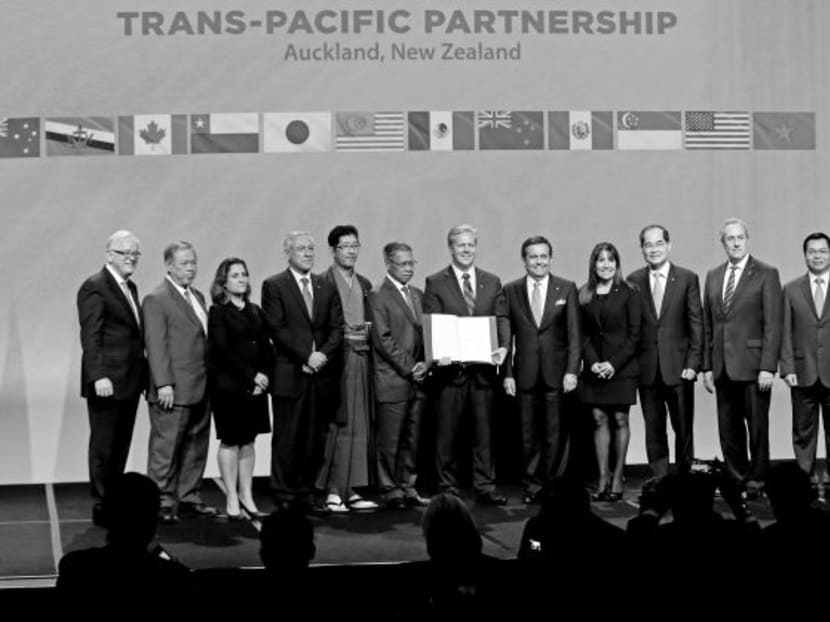Opportunity for 11 remaining nations in TPP to strike deal this week
TOKYO — The 11 signatories remaining in the Trans-Pacific Partnership (TPP) free trade pact will have an opportunity later this week to strike a deal to implement the agreement after the withdrawal of the United States.

Officials from the 12 signatory countries after signing the Trans-Pacific Partnership (TPP) agreement in Auckland last year. The US represents nearly 62 per cent of the TPP’s gross domestic product. Photo: AFP
TOKYO — The 11 signatories remaining in the Trans-Pacific Partnership (TPP) free trade pact will have an opportunity later this week to strike a deal to implement the agreement after the withdrawal of the United States.
The 11 states are aiming to salvage the pact without the world’s biggest economy as they gather on the sidelines of the Asia-Pacific Economic Cooperation ministerial and summit meetings from Thursday (Nov 9) in the central Vietnamese city of Danang.
“There remain big challenges, but Japan will make utmost efforts to make a high-standard agreement,” Mr Toshimitsu Motegi, minister in charge of the TPP trade negotiations for Japan, told reporters before departing for Vietnam.
Mr Motegi also said that Japan and Vietnam will serve as co-chairs of the TPP ministerial meeting and seek a broad agreement on the pact.
Major proponents such as Japan and Australia have been trying to revive the regional trade initiative after the withdrawal of the US, while Tokyo also sees the pact as a way to shield itself from demands by Washington to start talks on a bilateral free trade agreement.
In the wake of the US pullout, the 11 remaining countries decided to temporarily suspend implementation of some clauses until such time as Washington might return to the deal.
Despite rounds of talks by the countries’ chief negotiators, they are still at odds over which agreements on trade and investment to shelve while maintaining a high level of liberalisation.
Requests for suspension include agreements on rules that restrict the scope of apparel products subject to tariff cuts and elimination and on preservation of copyrights and trademarks for 70 years after creators die, a Japanese negotiation source said.
The calls for suspension on key issues come from countries, like Vietnam, which have relaxed domestic regulations despite opposition in return for better access to the large US market, the source said.
New Zealand’s new Prime Minister Jacinda Ardern, who took office last month, has become a fresh source of concern, after she said she intends to seek review of the inclusion of an investor-state dispute settlement system in the TPP.
The system gives a foreign company the right to sue a state for compensation under an international tribunal, but Ms Ardern has said it will put domestic companies at a disadvantage.
Japan's chief negotiator Kazuyoshi Umemoto told reporters last week that although there is no great change in New Zealand's attitude to remain committed to the TPP, he cannot rule out the possibility that the country may make a new request.
Another issue the countries need to address is a clause stating that the TPP pact can only come into force after six members, accounting for at least 85 per cent of the original 12 signatories' combined gross domestic product, complete domestic procedures.
As the United States alone represents more than 60 per cent of the initial members’ GDP, it is impossible for the pact to come into effect under the present terms.
The 11 countries are seeking to agree on a new, 11-party framework.
Japan hopes that the United States will come back to the TPP framework in the future but US President Donald Trump again rejected the idea during his visit to Tokyo on Monday (Nov 6), saying that the pending regional free trade agreement was “not the right idea”.
The TPP was signed in February 2016 by the 11 countries and the US. China is not part of the framework.
Mr Trump announced Washington’s withdrawal from the pact after taking office in January this year, saying Americans would lose jobs if it joins the multilateral free trade deal and that he prefers pursuing bilateral trade agreements.
The pullout came as a shock to the other 11 members, given that the deal was a pillar of Mr Trump’s predecessor Barack Obama’s policy of a strategic rebalance to the Asia-Pacific region. It had significance not only economically but also security-wise amid the rise of China.
The 11 TPP countries are Australia, Brunei, Canada, Chile, Japan, Malaysia, Mexico, New Zealand, Peru, Singapore and Vietnam. With the United States, the trade pact covered around 40 per cent of the global economy. KYODO NEWS






